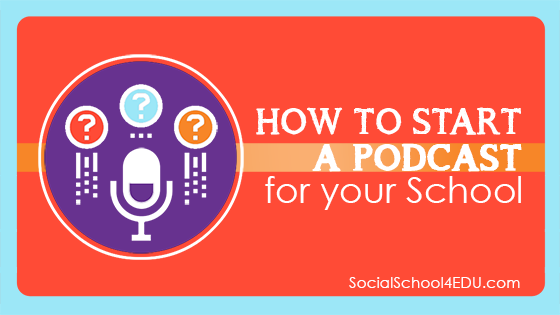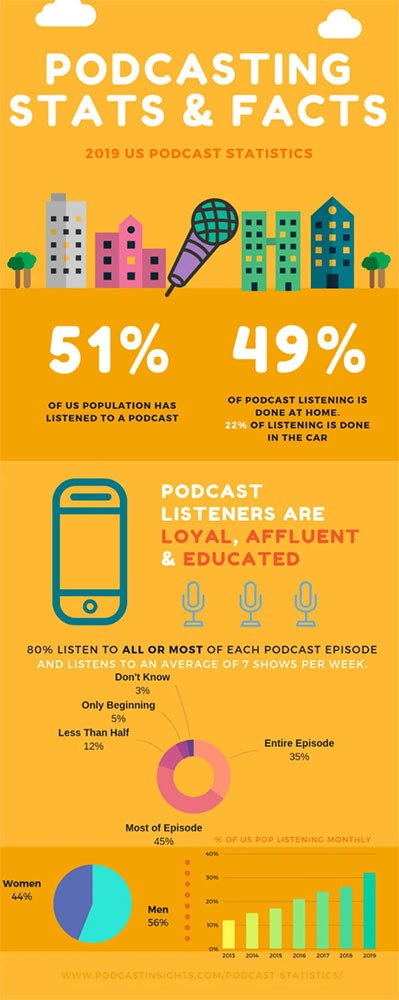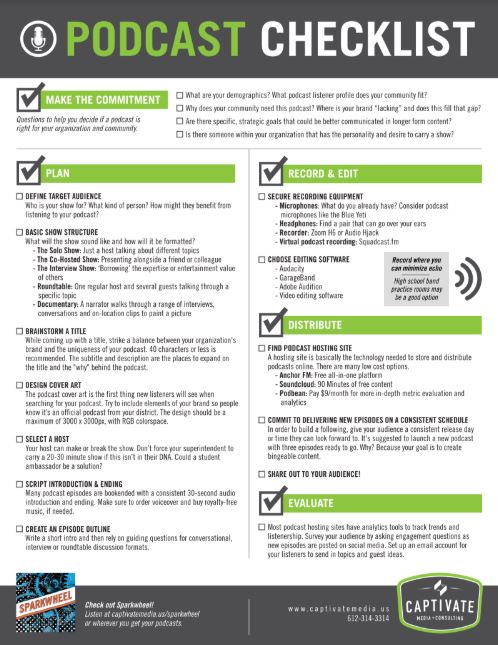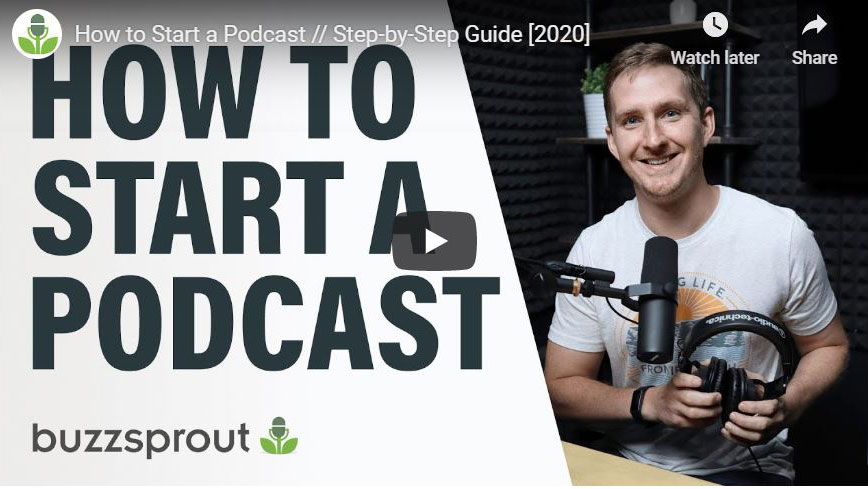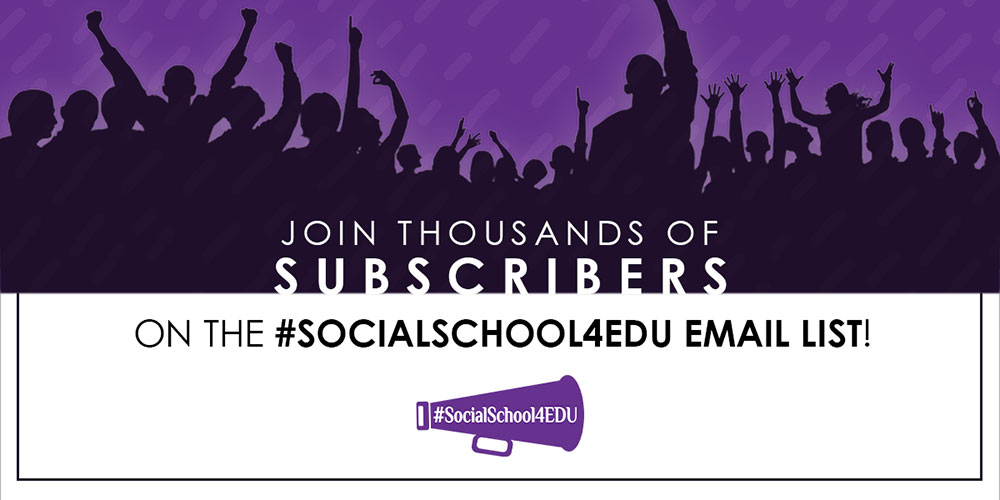When Carla Pereira, APR started working for the Peel District School Board in the communications office in 2003, her first assignment was pretty exciting.
She sat next to the fax machine and waited for the news stories to come in from the various schools.
Fast-forward to 2020, and I’m curious: Do any schools still have a fax machine?
If you have a story, you just tweet or retweet it to the world!
So while communication tools have evolved to make it easier to broadcast your stories, it has created another issue: How do you stand out enough to be heard or seen?
We hope you’re using your website to share important updates. We hope you have a district Facebook page full of engaging posts and are sharing Instagram Stories to connect with your students. But if you’re ready to take on a new challenge, you might want to consider podcasting! After all, the reason I know about Carla’s story is because I interviewed her for my podcast. You can listen to her episode right here.
Here are just a few podcasting statistics to pique your interest (sourced here):
- 50% of all U.S. homes are podcast fans
- 55% of the U.S. population has listened to a podcast
- 49% of podcast listening is done at home, 22% listen while driving
- 56% of listeners are men
- 80% listen to all or most of each episode
If having a captive audience sounds appealing to you, your school might be ready to start its own podcast. My friends at Captivate Media have created a helpful podcast checklist for schools. Download it here. Read on for a bit more insight into some of their steps!
Make the Commitment
I learned that creating a podcast was easier than I thought it would be, but it does take time and resources. You and your district have to be committed to making it happen.
Start with why.
Why do you want to create a podcast? What strategic goals could be better communicated in longer-form content?
You also have to identify who is going to “own” the podcast. This person doesn’t have to be the podcast host – but there has to be someone who is going to make it happen! If that isn’t clearly laid out, you’ll be set-up for failure. And I would recommend selecting someone who is already an avid fan of podcasts.
Plan
Failing to plan is planning to fail. You have to have some foundational pieces well-thought-out when you start – and that starts with defining your target audience. Who are you trying to reach? What kind of person? How might they benefit from listening to your podcast? If you can’t answer these questions. stop right now.
You might be thinking, “I want to reach all of our parents in our district.” But that isn’t realistic. I find that my favorite podcasts are very targeted. They aren’t talking about a range of topics from episode to episode. They dive deep into a specific niche. Here are some ideas for focus areas:
- Highlighting innovative teaching practices from across your district
- Sharing student experiences to highlight the wide array of offerings of your school
- Providing regular updates and important news from the school board
- Digging into referendum/bond questions or long-range planning
Once you know who you are targeting and what your focus area will be, you’ll need to select a basic show structure. That checklist breaks down 5 options. I personally love the interview show option, where one host interviews another person. Spend a moment thinking about your school or district. You actually have an endless list of podcast guests!
If you’re looking for inspiration from other schools, here are a few examples:
You’ll also want to decide the frequency of your podcast. I’m committed to doing a weekly show with my Mastering Social Media for Schools podcast – 52 episodes a year. I’m betting that this frequency makes you sweat! You could start with a monthly show and grow it from there. Some podcasts do “seasons.” This might mean 8-10 episodes and then you take a break. You can start again when you have more to say!
After you decide your podcast frequency, you still have to plan a title, design cover art, select your host, and script your introduction and ending for each episode. I said script it – not actually record it. That comes next.
If that last paragraph again makes you sweat, I want to share an awesome blog that walked me through starting my podcast. It has great advice that is easy to follow! Read How to Start a Podcast from my podcast host, Buzzsprout. It also includes a video if you’d like to watch and learn!
Record & Edit
You will need some basic equipment to get started. Captivate’s checklist has some great recommendations, but I’m going to share what I’m actually using.
Microphone: Even just a phone or a computer that can record audio can work. Right now, I use a Logitech h390 USB headset that I bought on Amazon. When I first started, I used my earbuds that came with my iPhone (remember, the volume control is a microphone). This basically covers both of the microphone and headphone needs.
Recorder: You can record your interviews through apps like Zoom. I highly recommend doing virtual interviews because it makes scheduling so much easier! As I write this, we are still under some safer-at-home guidelines. Even when you can interview people in-person, you aren’t stuck doing so.
I purchased a monthly subscription to Squadcast.fm. I find the audio quality amazing and I can see the person I’m interviewing, making it a very natural interaction. The pricing is affordable. I have the “Creator” plan that costs me $200 per year or roughly $17/month. They have a “Dabbler” plan for just $9/month and you can record up to 2 hours per month.
Once you have the recordings complete, you’ll need some software to edit pieces together – like your intro, outro, content, and any theme music you want to add. GarageBand and Audacity are both free and pretty easy to use. That blog from Buzzsprout has more information about these software options. Allison, my graphic designer at #SocialSchool4EDU, does all of my video and podcast editing, and she uses GarageBand.
Distribute
Once you have your podcast complete, it’s time to distribute it! You can share it on your website, but the whole point of podcasting is to meet people where they are and make it easy to listen. This means finding a podcast hosting site.
A hosting site is basically the technology needed to store and distribute podcasts online. This site will get your podcasts to the various platforms and apps (like Apple podcast, Spotify, Stitcher, and others).
Anchor FM is a free platform that many schools use. Soundcloud and Podbean are other options. I mentioned Buzzsprout. I pay $12 per month for up to 4 hours of audio. My podcast length is between 30-40 minutes, so that is plenty for my weekly show. They have a free option for up to 2 hours each month. (Note – my hours may be slightly different. I went through an affiliate from my friend Pat Flynn. You can get the same pricing by using this link.)
These sites make it very easy to upload your audio file, add a title, and include a description of your episode. You’ll want to give your audience an idea of what they will learn from listening to each episode. If you make any references to your website or documents that people need to access, make sure to include links in the description. I refer to them as “show notes” and mention them during my podcast interviews so that people know they can find them after they are done listening.
Now that the episode is there, your work isn’t done. You should let your community know that the podcast is available by promoting it on social media, in your newsletters, on your school website, and more. Make sure to invite your community to “subscribe” so they don’t miss an episode!
And of course, after you upload your first podcast, you’ll need to start thinking about your next! Podcast listeners are loyal and they love a schedule. If you say you’re going to release a new podcast each month… well, you better do it!
Evaluate
As with anything in education, there is always a reflective stage. You can review your podcast analytics within your podcast hosting site. You’ll be able to get overall downloads, a breakdown per episode, and you can even see what days of the week people are listening to your podcast. Use this data to drive content going forward. If one specific episode is popular, reflect and ask yourself why that topic or guest may have reached more people.
You should also listen to the podcasts yourself. As the host of my new show, I cringe at some of the things I say or the timing, but I know I’ll get better! As a school, you may interview a particular student that just shines as a guest. You may want to consider having that student on the show more often – or even turning that student into a host! It’s all about learning as you go.
What now?
Are you ready to start a podcast for your school? Maybe? Or maybe not? Either way, this blog is here for you when you need it.
And if you just want to start learning from some other podcasts that might help you with #SchoolPR, check out this blog on my 8 favorite podcasts.

